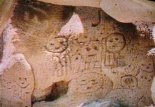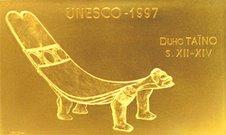
Since 1994, Dr. Juan Carlos Martínez Cruzado has been working on the quest to find the origins of the Taínos. The genetic professor from the Biology Department of the University of Puerto Rico in Mayagüez (UPRM) confessed that the only thing that he knew before about the first inhabitants of our island was what his 5th-and 11th-grades history classes taught him.
He recalls that the archaeologist Juan José Ortiz Aguilú, director of the Archaeology Program of the Institute of Puerto Rican Culture, was the person who awoke his interest on this topic, when he offered Martínez Cruzado the chance to investigate the mitochondrial genetic material (mtDNA) of an ancient skeleton.
Although the majority of our genetic material is inside the nucleus of our cells, the mtDNA can only be found outside the nucleus in an organelle called mitochondria. Martínez Cruzado, a Harvard Ph.D., clarified that the mtDNA is 200,000 times smaller than the nuclear DNA.
“We all possess the mtDNA, but it’s only transmitted by mothers,” explained the
professor. Also, in the mtDNA a mutation or change in composition occurs each 3,000 years.
Because of this, the mtDNA can be preserved through many generations and help trace human migrations around the world. Although racial mixing has been a common historical phenomenon in the Caribbean, there are mtDNAs that have maintained their original state and can be identified as African, Taíno or Caucasian. “The evolution of human kind is written on the mitochondrial DNA”, he stated.
At the beginning of his research Martínez Cruzado searched for Taíno ancestry by
extracting mtDNA from bones. This technique was discarded because the results didn’t show variety in the genetic material extracted, and the technique was too expensive and complicated.
The professor, then decided to collect hair, saliva and blood samples from people with typical Taíno traits to obtain their mtDNA. Between 1998 and 1999, the investigation was based on analyzing the mtDNA of voluntaries from UPRM and Indieras, Maricao. The study revealed a higher incidence of Taíno DNA in people from Indieras whose physical appearance resembled Taínos: black hair and slanted eyes.
The professor then obtained funding from the National Foundation of the Science of United States to analyze the mtDNA of a representative sample in Puerto Rico.
Martínez Cruzado found 19 maternal lineages; nine of which have enough frequency and variability to suggest that they go back to the pre-Columbian period. “All the members of each lineage share a great-great-grandmother. These great-great-grandmothers are responsible for all the lineages in the world and share an African great-great-grandmother,” explained the scientist.
The study shows that the majority of the Indian lineages in Puerto Rico originated in the Amazonic region.
Martínez Cruzado’s study has been published in many scientific journals, including the American Journal of Physical Anthropology in September, 2005. The professor has extended the investigation of Indian migrations in the Caribbean region to the Dominican Republic and Haiti, where he has also found mtDNA with Indian heritage. The results are expected in 2008.
Author: Margarita Santori López, PRENSA RUM
Source: http://www.uprm.edu/news/docs/UPRMNews2008009.pdf
 A monument to the Taino Kasike (Chieftain) Guarokuia or Enriquillo in the Dominican Republic. Guarokuia led a successful rebellion against the Spanish forces resulting in the first treaty between Indigenous Peoples and colonizers in the western hemisphere.
A monument to the Taino Kasike (Chieftain) Guarokuia or Enriquillo in the Dominican Republic. Guarokuia led a successful rebellion against the Spanish forces resulting in the first treaty between Indigenous Peoples and colonizers in the western hemisphere. 









